Tell Me Tuesday: DIY Toenail Surgery
My DIY Toenail Surgery
Reader advisory: this post is fairly gross because
1. My feet, while quite useful, are not very attractive. I have not had a pedicure since late April, I think.
2. And when I shoot them close-up to show all their blisters and flaws, they’re downright disgusting.
Consider yourself warned.
I had very few nail issues while training for Ironmother. The second toe of my right foot, as usual, was the martyr of the 10, and was constantly sore. Also, due to the fact that I’ve lost and regrown that puppie about, oh, 17 times at this point, the nail was thicker than a dictionary.
But 26.2 miles at the end of an already long day brought on some damage. Fortunately, I didn’t feel much pain (in my feet) until after the race, but then it was all I could concentrate on: a huge blister under my left big toenail, a few smaller blisters on other feet, and on Mr. Purple Martyr, a blister under the nail, a blister around the nail, and a very angry nail to boot.
It took me a few days before I could even think about touching them to relieve the pressure. But my kids, not exactly feathers, seemed to be stomping on my flip-flopped feet more than usual, and I was not very nice to them when they did. So I popped all the blisters that were not under a nail bed, and there was excessive launching of liquid. Since this is a gross post, I’ll just spill all the details: I popped one on Tuesday night. Total geyser. It was still sore, so I went at it again on Wednesday night. Mini-geyser. I think I lost a pound just with that one.
And then it was time to get serious. Here’s how I popped my under-nail blisters.
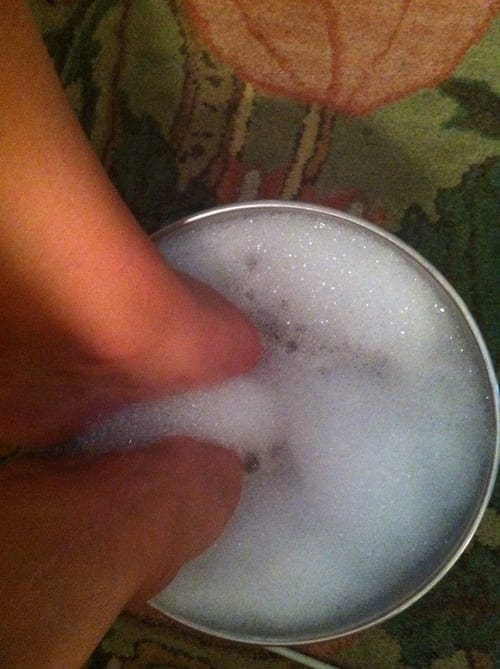
1. Soak both feet in soapy water. Helpful tip: do not make the water too hot. That is just as painful as a 80-pound child on your ailing feet.
Also: you may not be able to tell from this pic, but I had *serious* cankles and fat feet after the race for about 10 days. I slept with 110% calf sleeves on, but that didn’t help my feet, which felt as wide as they are long. Serious dinner rolls. I couldn’t hack the socks because my toenails hurt so much—way too much pressure on them. I tried to keep my feet up as much as possible, but I sleep on my side and this mother thing kept getting in the way…anyway, I digress.
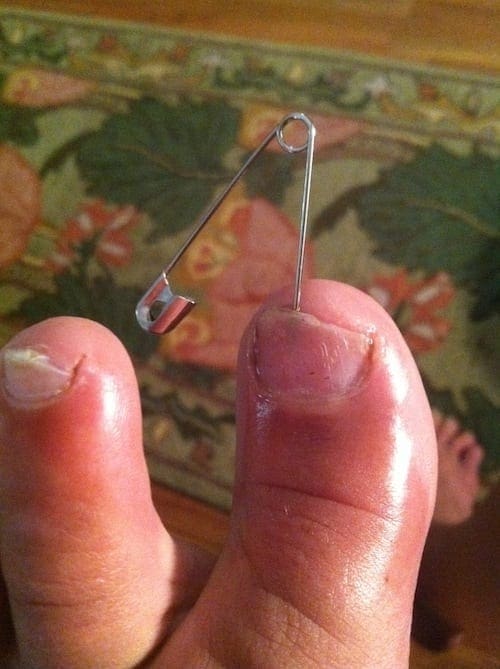
3. Then take a deep breath, and head on under. I had to go in several times to release all the liquid/pressure. So gross, but ahhh.
I poked around a little under Mr. PM, but I couldn’t find any relief, so let him just keep throbbing. Plus, that little procedure was enough for one night for me.
Two days later, I was at my Mom’s house, where I took a bath. (I barely fit in the bathtub at my house; I use it only for ice baths, when I’m going to be uncomfortable anyway. When I win the lottery, we’re doing a total bathroom remodel so I can have a large tub where I can actually straighten my legs and recline just slightly.) I sat in there for quite some time with both feet submerged, and then, of course, I had to inspect my feet. I realized I could just rip the horse hoof on Mr. PM right off, so I did. Little to no pain with that situation and, fortunately, I decided not to photograph it for you.
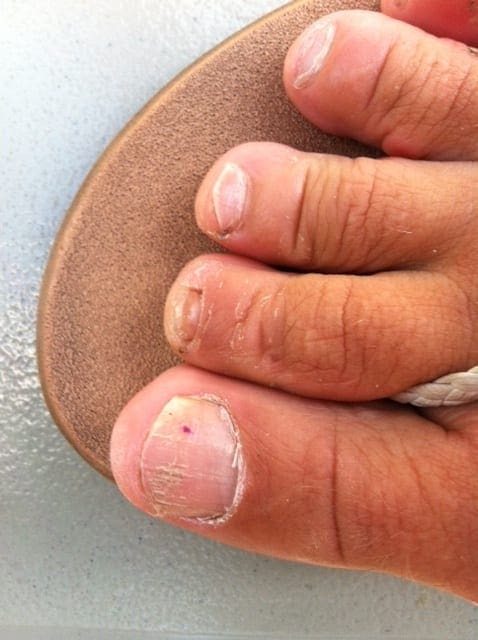
But here’s Mr. PM, about 10 days later. Look at that beautiful, tiny bloom of a toenail…guessing grossness will set back in when I start running regularly again.
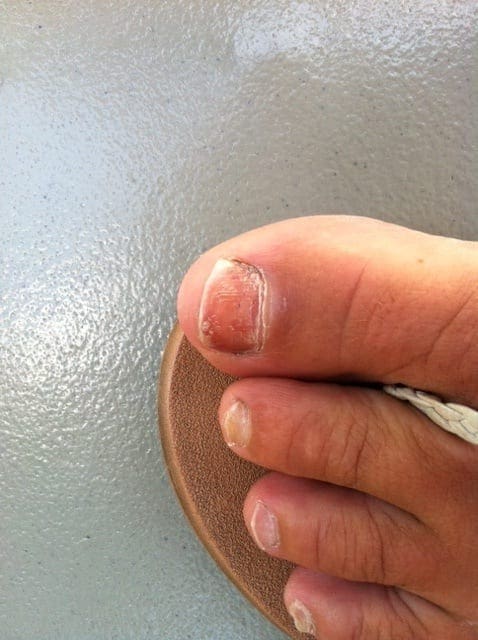
And this is the nail that was operated on. It’s dark underneath, but doesn’t hurt a lick. Guessing I might lose that nail, though not 100% sure.
And that, dear readers, concludes this tour through my Ironmother toenails.
Now you tell us: what do you do when you have a blister or other issue? Do you dig in yourself?
Sarah and Molly’s Saturday Run
Brightly sunny with just a hint of coolness in the air, Saturday was a perfect summer day for running. I set off to meet Molly, wearing a smile. Two GU packets were tucked into my Ultimate Direction Thunderbolt belt; the bottles held cold orange nuun. Molly and I had a lot more catching up to do—during our five miles on Wednesday morning, we’d only scratched the surface of my family’s trip to San Francisco and the goings-on of her three teenage daughters. I excitedly felt our 12 miles, prep for the Happy Girls Forest Grove Half-Marathon, were going to roll by in a blur.
Instead, it turned into an epic fail.
All week, Molly had been fighting what we joking called, “the plague,” a hacking cough that refused to produce any spit-able results. On Wednesday, we’d decided to skip 2 x 2 miles at tempo; Saturday morning I told Molly if she didn’t feel up for it, we didn’t have to run 4 of our 12 miles at half-marathon pace, as the Half-Marathon: Own It plan from Train Like a Mother: How to Get Across Any Finish Line – and Not Lose Your Family, Job, or Sanity called for. But when we stopped for our first GU at mile 4, she gamely reminded me we needed to pick up the pace. We agreed anything under 9:00 sounded good. (Up to that point, we’d been running 10- to 10:15-minute miles.)
After resetting my Garmin, I gave my legs and lungs some time to settle into the faster pace. A right turn, another right turn, then a left onto a slightly uphill road, and I was still waiting for the pace to feel good. Or even not torturously difficult, which was what it was feeling to me. Relaying a story about my family’s visit to Muir Woods, I could only gasp out a few words before gulping oxygen. “The twins argued….and whined…yet Phoebe….was oblivious…pointing out…sword ferns and…hemlock trees….” Since when had 8:40-minute miles felt so heinous?
“Can we blame this…on the two pints….of beer…I drank last night?” I asked.
By the time we turned onto a flat straightaway, Molly was a step or two ahead of me, something that had never happened to us in the middle of a run. Usually she starts a run faster than I like, but our paces are usually well matched for most of a run, and I always have a strong finish. My face was slick with exertion: I flicked sweat off my eyebrows in an effort to stop it from running into my eyes. Another turn onto another flat road, one of my favorite long stretches—wide fields on either side were home to numerous songbirds and wildflowers. But at just over halfway into our four miles at race pace, I could only concentrate on Molly’s bright orange tee. We’d given up trying to talk; I was barely hanging onto a 9:20 pace. Forget sub-9:00s.
It made no sense: A week before, thanks to being in my beloved San Francisco and a peppy race playlist on my iPod, I continually found myself running race pace without even trying. Now my legs refused to move any faster, and my body felt starved for oxygen. My hands were cold, and my forearms tingled like they have the few times I’ve run a timed mile. Staring at Molly’s back, a cacophony of thoughts pinged in my head: “I’ll never run fast again. Getting old sucks. How did I ever run that marathon faster than Molly? She’s kicking my butt on hill repeats lately. I’m slow. I’m old. This sucks.”
Then, out loud, “I give in….Molly, you go ahead.” And, just like that, just past three miles, I did something I never do on a run: I slowed to a walk. Molly kept chugging along; I soon lost sight of her vivid tee. After a few minutes, I tried to resume running at race pace, which lasted all of about 90 seconds. I walked some more, then finally started running a slow shuffle. Now all I kept thinking was, “wait for me, Molly; please wait for me.” The idea of running five miles home solo, with no music, loomed interminable, like sitting through a three-hour economics lecture—in Swahili.
I was losing hope when I heard her say, “Over here, Sarah.” Phew: There was Molly, sipping her water and suggesting we splash cold water on our faces at the bathroom of the adjacent DMV emissions-testing center.
Usually a disco-bath reinvigorates me but the effects of this one only lasted a few steps. Even at a much slower pace, the miles’ long incline back toward our houses was a major slog. It seemed even the birds were mocking my effort, “Caw-caw-CAW!” At one point, after bending down to pick up a rusty nail in the road, I complained about feeling dizzy. “I think you’re coming down with the plague, too,” Molly suggested kindly. I just thought, “Nope, I’m just old and slow.”
About 11 miles into our run, Molly started telling me about this woman she knows who trains guide dogs as well as doing all other sorts of volunteering. We got to talking about how it seems the majority of volunteer work is done by a minority of people.
Bam! It hit me. “I donated blood yesterday, Molly! I donated blood!” I doubled over, clutching my stomach as deep laughter shook my body—then tears sprung to my eyes. I wasn’t going to run a woefully slower-for-me pace for the rest of my life; my fitness wasn’t in the toilet. I was just down a pint of the good stuff!
I was still gasping for air for that final mile home, but at least now it was because I was chuckling—and there was a reason for my slow down.
Mother runners: How does donating blood affect your running?
Shiver with Race Anticipation
Recorded when Dimity was mere days away from tackling her Ironman triathlon, the mother runners discuss the days (and hours and minutes) leading up to a starting line. They reveal when the reality of a race sets in for them: For SBS, it’s all about dairy product expiration dates; for Dimity, it’s often not until morning-of. They lament second-guessing elements of training, whether it’s foam rolling, core work, or end-of-run strides. (All fall under the category of, “shoulda, woulda, coulda,” for Sarah.) In their taper-talk, Dimity offers the pearl of, “Keep up on some intensity, but cut back on the volume.” Then Dim sums up toeing the line in a nutshell, “This is what we do.” And by “we,” she means mother runners.
[audio:http://www.podtrac.com/pts/redirect.mp3/podcasts.pagatim.fm/shows/amr/amr_071113.mp3]Heads up: On Wednesday, July 17, we’re going to do our closest approximation of a call-in show (we love “Car Talk”!), and we need 6 to 10 women to partake. Here’s the deal: If you have a question to ask us—it could be about training, tempo, TMI, or any other running-related topic—email it to us at runmother [at] gmail [dot] com. To be one of the gals we include, you need to have a reliable internet connection, a Skype account, headphones (even cheapo earbuds work), and a quiet room during the hour from noon-1 p.m. Pacific on 7/17. Please respond by end of day Monday, July 15. We’ll let you know on 7/16 if we’re going to have you “on” our show!
**Also, the quickest way to get our podcasts is to subscribe to the show via iTunes. Clicking this link will automatically download the shows to your iTunes account. It doesn’t get any simpler than that!
Running with Kids: 5 Ways to Make Family Racing Memorable (And Fun!)
After several years running the summer 15K in my northern Michigan hometown’s annual National Cherry Festival, I switched over to the 5K. It’s typically sweltering on race day—it takes place the final day of the weeklong festival in early July—so I welcomed the shorter distance event. It also marked the first time my family of five ran a race all together. This was a year ago, and this past week we again got up early, pinned on race bibs, and toed the race start line together. I’d like to think we’ve created a new family tradition, complete with cheesy-fun matching race shirts and silly pre- and post-race photos.
Based on the many adults with kids we saw participating in our local 5K, and the responses received earlier this week on the AMR Facebook page about this topic, making races a family affair appears to be pretty popular. With so many races, particularly 5Ks, taking place nearly every weekend throughout summer and fall in communities across the country, there’s plenty of opportunities for families to get out there and run together. As mother runner Mary Frances shared with the tribe, “Running is a wonderful sport for families! All five of our kids run and all love racing … especially when we bring home bling!”
Whether you’ve run several races as a family, or it’s something you’re considering trying, BAMRs offered lots of sage advice for ensuring the experience is a fun one for everyone. Here’s a sampling of what’s worked (and not gone over so well) when it comes to racing with kids:
Start Small. Short races—one mile or less—can introduce your child to the “race” experience without being too overwhelming. Melissa’s twin boys, 3, participate in these kinds of events. “They get their own bibs and practice for weeks by looping the kitchen/living room,” she says. Mother runner Kristin says her oldest, age 5, is doing 1-mile fun runs for now. “Training” consists of playing outside and running around the playground, she says. “We follow his lead with the fun runs—run when he wants to, and walk when he wants to. I do a lot of reminding him that we are all winners and we aren’t trying to beat everyone else. As long as we do our best, we all win.” (Though she acknowledges he’s still learning this last part.) Melissa T., whose 5-year-old just ran her first one-mile race, now wants to move onto a 5K. “I think it’s best to start with a short distance, make it positive, and then move onto bigger distances,” she says.
Pre-race runs together help a lot. Beth, who ran her first 5K two years ago with her then-9-year-old daughter, says they followed a couch-to-5K program together. “Since then my whole family has become runners and my daughter, who is now 11, is signed up for her first sprint triathlon.” The family runs together to get ready for races: “We do most of our training runs at three miles so they are used to the distance and we stress that they listen to their bodies and not start too fast.” Several mother runners shared they follow a training plan such as ones used for a Girls on the Run 5K.
Manage expectations (theirs and yours). Long before the start gun goes off, talk through what’ll happen race day. In other words, discuss whether everyone will be running, walking, or doing a combination of both. Will everyone stay together the entire way, or is it OK for, say, older kids to go ahead? This year we all started together but eventually our 13-year-old and 11-year-old took off together, which we knew would likely happen. This meant Joe and I stayed with Alex, 7, and while we mostly ran, we also knew we’d take a few walk breaks with him along the way. We also had talked ahead of time about where we’d all meet in the finish area. Several mother runners also shared stories about emphasizing the importance of pacing to their kids. “I give them a little advice about starting off slow,” says Kimberly.
Inject some fun into it. Donning costumes can add even more excitement to the race, several mother runners shared. “My entire family—two adults and the four kids, ages 10, 6, 5, and 20 months—participated in a Superhero 5K,” says Melanie, “and things that made it successful were costumes and that is was for a family-friendly cause.” (The race helped benefit child abuse prevention). Pam offers this suggestion for race-wear: “We let them wear funky socks and tutus to make the race extra fun.” Laura suggests having your kids invite a buddy or two: “Adding some friends to the mix makes the race more fun for them. We also play “I Spy” and guessing games, and if they whine too much I threaten to sing. Family races are about having fun—throw out ideas about running at your normal pace.”
Bring extra water & goodies. Even with aid stations along the race route, mother runners know having a little extra something can come in handy. “I carry water and extra energy chews for her, which seemed to help with encouragement when needed,” says Krista, who ran a 5K earlier this month with her 6-year-old daughter. Kelly says she “felt funny carrying water in a 5K with my kids,” but wanted to be prepared. “Sure enough, they always want water when we are no where near the water station. It can also be used as a distractor if they start complaining.”
Have you run a race with your kids? As a family? What helped make your experience a memorable one?
I Wish I Had My Jessie Girl—and Her Snore

Sweet dreams, sweet Jessie girl.
Jessie was the kind of dog that, at 5 am, would ask to get up on our bed. And if I responded yes—how could I say no to sweet Jessie?—she’d launch herself up to the bottom of the bed, twirl around about seven times, and then tuck herself into a tight ball, seemingly wanting to disturb as little as possible. No licks, no wet nose, no stomping on my stomach, just happiness to be near my toes. And then, within about 20 seconds, her rumbling, rhythmic snore filled the air. I will take silence over almost any noise, but her rumble was my favorite noise. It was the noise of contentment. I’d press snooze more often than not just to soak it in.
She came to live with our family about six years ago, when Sarah, my younger sister, formerly a marketing manager at the Humane Society, realized her tiny carriage house was a little too full of four-leggeds and fur. Sarah had adopted Ms. Jessica Simpson, named for her fab blonde hairdo and the way she sang when she saw her leash and knew a walk was imminent, shortly after Jessie came into the special needs section of the Humane Society. She’d been hit by a car, and the damage was pretty comprehensive: her head was split (thus the rad faux-hawk you can see in the picture above); her back was scabbed; her back leg was totally out of whack.
Sarah brought Jessie to us the night of Thanksgiving in 2007. That night, after some whimpering when Sarah left and some aimless wandering looking for her, I heard her bulldozing beneath our dining room table. That peaceful noise made me realize she’d be as happy with us as she was with Sarah, and I was flooded with relief.
I know all dogs give unconditional love, but I also know, from plenty of experience, not all dogs are low-maintenance. Jessie was, by a mile, the most mellow, least demanding member of this house. Sure, she used to get into Ben’s diapers back in the day when I’d forget to shut his door. Sure, she started asking for her dinner around 1:17 p.m., when I didn’t feed her and her sister/brother until at least 3:30. And sure, her blonde fur stuck to every.single.thing in this house. (If I shipped you an AMR shirt and there was a blonde hair in there, apologies. I promise she never came into contact with them; her fur seemed to have legs of its own.)
While it’s disgusting to deal with dirty diapers a second time around, those are minor details compared to her quiet gratefulness she oozed into our lives. A sense that she was just glad to have a safe place to lie her head, that her itinerant lifestyle was over. She was, as I imagine most beings who have been significantly damaged are, just happy to feel pure love and live a simple life with a routine she could count on: breakfast, outside, walk, sleep, dinner, outside, sleep.
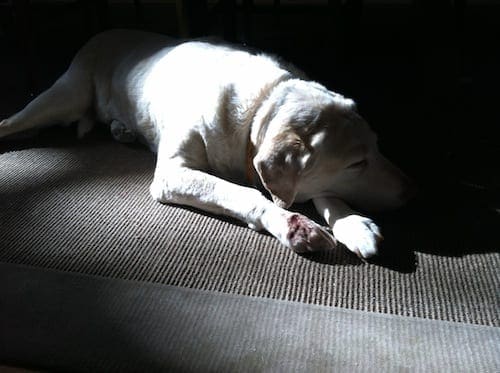
Jessie in repose. Her wound on her paw never healed when we had her: she’d obsessively lick it, and finally, after trying a variety of treatments, we’d just let her.
And while she enjoyed her uncomplicated existence, I was the one who truly reaped her blessings. In the middle of the day, I’d often take a break to talk to Jessie Girl about anything that was on my mind: work, news, kids, life, anything stressful. She’d moan and groan as I petted her, as if to tell me, at that very moment, she needed her left armpit scratched exactly in that place, exactly the way I was doing it. With each stroke, I grew calmer and calmer.
She was equally as vocal about her visits to the spa—our backyard, where I brushed her over and over to try to get her to a temporarily shedless place (impossible, btw)—that I’d turn a 5-minute chore into a 20-minute luxury treatment because her appreciation was so abundant.
Due to cataracts, her eyesight diminished over time, and her eyes became marbles. She gently grazed walls, capably finding her way to her necessities: water, the door outside, her bed. (I’d always put her food bowl right in front of her.) She could walk surprisingly fast for a dog with little vision, and it was only the past year or so when she stopped taking the stairs by herself. Grant or I would pick her up like a forklift—one arm under each set of her limbs—and carry her up and down the stairs, where we’d deposit her on her bed. Although I’m sure she wouldn’t have complained to sleep downstairs, I was too addicted to hearing her snore.
About a week ago, Jessie, who, not surprisingly, had never been sick over the previous six years, had a really tough weekend. Eating, barfing, not eating, barfing, drinking water, barfing, eating grass, barfing, not drinking water, barfing. Sad, tired, skinny, drooling, banging around for a spot to find some relief. Again and again, I sat next to her to pet her, to try to get her to that relaxed place where she could snore. It wasn’t happening.
Grant and I talked about what we thought might be options, but then we realized, our 13-year-old Jessie Pie was done. She’d been through enough in this life. The next morning, the vet agreed with our decision, and Jessie moved one last time. Once she landed in the land of forever healthy, bounding hounds, she found her snore again. I’m sure of it.
Pace Like a Mother: A Chat with Coach Greg McMillan
Dimity and Sarah talk to the pace guru Greg McMillan, the coach whose online calculator is like a Magic 8-Ball for runners: It not only predicts the time of your next race finish, but also tells you what speed to muster on your long runs, tempo runs, and track workouts. In this podcast, Greg gives great injury-prevention advice for newbie runners, including to run less mileage than you think you can (love that!), as well as offers sane words on how to accept age-related slower paces. (Sigh.) And he answers the head-scratcher of race versus tempo pace.
If you’re digging our podcasts, we’d be super-grateful if you’d take a minute (because we *know* you have so many to spare!) to write a review on iTunes.
[audio:http://www.podtrac.com/pts/redirect.mp3/podcasts.pagatim.fm/shows/amr/amr_070413.mp3]**Also, the quickest way to get our podcasts is to subscribe to the show via iTunes. Clicking this link will automatically download the shows to your iTunes account. It doesn’t get any simpler than that!












